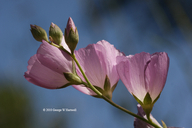Taxon Report
Sidalcea robusta RoushButte County checkerbloom |
 © 2010 George W Hartwell |
Taxon Summary
Sidalcea robusta, commonly known as Butte County checkerbloom, is a perennial rhizomatous herb in the Malvaceae that is found only in California. It occurs within Chaparral, and Cismontane woodland, growing at elevations from 90 to 1600 meters. Sidalcea robusta is ranked 1B.2, Plants Rare, Threatened or Endangered in California and Elsewhere; Moderately threatened in California.Classification
|
Scientific Name: |
Sidalcea robusta Roush |
|
Common Name: |
Butte County checkerbloom |
| Family: | Malvaceae |
| Element Code: | PDMAL110P0 |
| USDA Plants Symbol: | SIRO2 |
|
Synonyms/Other Names: |
|
Ecology and Life History
| Lifeform: | perennial rhizomatous herb |
| Blooming Period: Apr-Jun | Apr-Jun |
| Elevation: | 90-1600 (295-5250) |
| General Habitats: | Chaparral, Cismontane woodland |
| Microhabitat: | |
| Microhabitat Details: |
Conservation Status
| CA Rare Plant Rank: | 1B.2 |
| Global Rank: | G2 |
|
State Rank: |
S2 |
| State List: | None |
| Fed List: | None |
| Other Status: | BLM_S; SB_UCSC |
|
CRPR Changes: |
|
Occurrence Data from the CNDDB
| Total Occurrences: | 38 |
| Element Occurrence Ranks: | |
| Excellent (A) | 3 |
| Good (B) | 5 |
| Fair (C) | 1 |
| Poor (D) | 0 |
| None (X) | 1 |
| Unknown (U) | 28 |
| California Endemic: True | |
| California Counties and Islands: Name (Code) | |
| Butte (BUT) | |
| Quads: Name (Quad Code) | |
| Cherokee (3912165), Chico (3912167), Cohasset (3912186), Hamlin Canyon (3912166), Paradise West (3912176), Richardson Springs (3912177) | |
Threat List Data from the CNDDB
| Threat List Total: | 12 | |
| EOs with Threat Listed: | Total EOs | % of EOs |
| 9 | 24 % | |
| Grazing | 5 | 13% |
| Other | 4 | 10% |
| Development | 3 | 7% |
| ORV activity | 2 | 5% |
| Erosion/runoff | 1 | 2% |
| Foot traffic/trampling | 1 | 2% |
| Agriculture | 1 | 2% |
| Biocides | 1 | 2% |
| Recreational use (non-ORV) | 1 | 2% |
| Road/trail construction/maint. | 1 | 2% |
| Improper burning regime | 1 | 2% |
| Non-native plant impacts | 1 | 2% |
Citation
California Native Plant Society, Rare Plant Program. 2025. Rare Plant Inventory (online edition, v9.5.1). Website https://www.rareplants.cnps.org [accessed 4 December 2025].